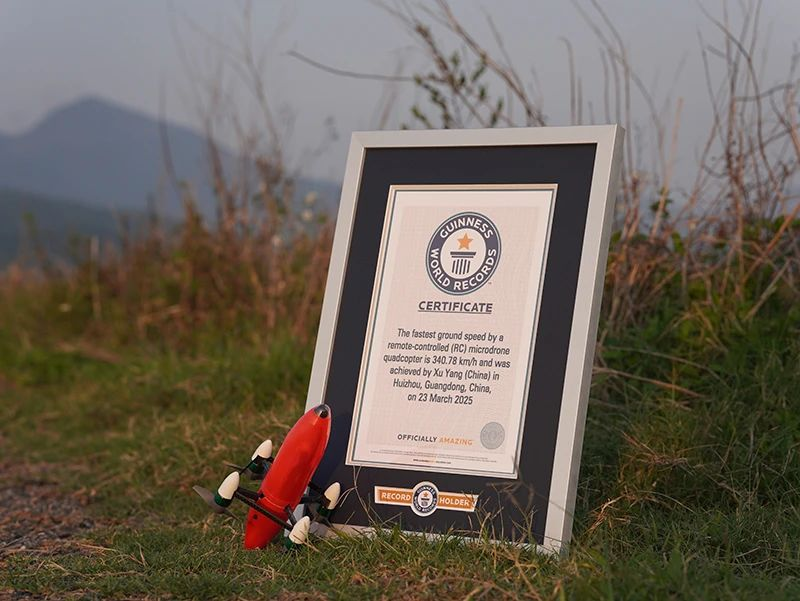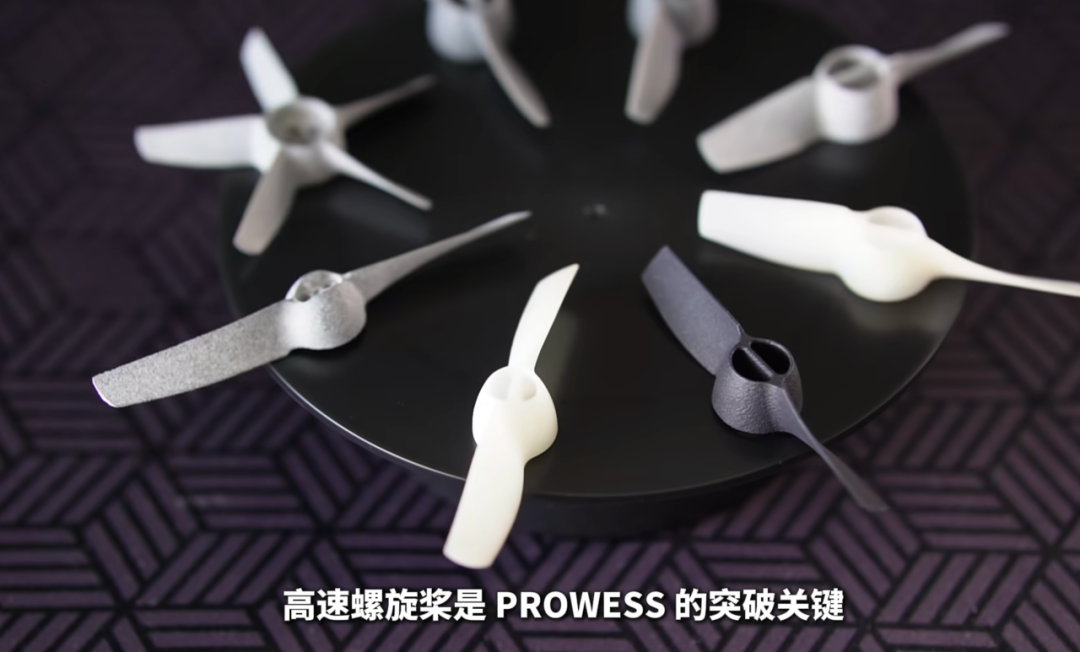 Source: Xinhua Daily Telegraph, compiled from Cover News, The Chinese University of Hong Kong (Shenzhen) WeChat Official Account, Guinness World Records, Shenzhen Big EventsCompiled by: Huang Liyuan, Chen RuiruiDid you know?The world’s fastest micro droneGuinness World Recordwas broken by a college junior!↓↓↓Xu Yang from the School of Science and Engineering at The Chinese University of Hong Kong (Shenzhen)created a newGuinness World Recordwith a self-builtmicro quadcopter called “Prowess”:The fastest ground speed of a remote-controlled (RC) micro quadcopter——340.78 km/h!
Source: Xinhua Daily Telegraph, compiled from Cover News, The Chinese University of Hong Kong (Shenzhen) WeChat Official Account, Guinness World Records, Shenzhen Big EventsCompiled by: Huang Liyuan, Chen RuiruiDid you know?The world’s fastest micro droneGuinness World Recordwas broken by a college junior!↓↓↓Xu Yang from the School of Science and Engineering at The Chinese University of Hong Kong (Shenzhen)created a newGuinness World Recordwith a self-builtmicro quadcopter called “Prowess”:The fastest ground speed of a remote-controlled (RC) micro quadcopter——340.78 km/h! This not only refreshes theextreme speed of micro quadcoptersbut also embodies a young person’sdream and passion for soaring in the sky.01A “High-Speed Rail Speed” Dream in Model AircraftIn the world of model aircraft, speed is always the most intoxicating romance. Xu Yang first encountered model aircraft in the fourth or fifth grade of elementary school. “I became interested when I saw someone playing with model aircraft in the park, and from then on, I couldn’t stop,” Xu Yang recalled. After entering university, Xu Yang continued to maintain his passion, actively participating in the forefront of model aircraft and focusing on a niche but highly challenging direction: micro quadcopters (Microdrone). Micro quadcopters refer to aircraft with a takeoff weight of no more than 250 grams. This category has extremely high requirements for the lightweight structure, power efficiency, and flight stability of the aircraft, making it a field with significant potential in the drone industry, while also being one where few can break its speed limits. The concept of high-speed micro quadcopters initially came from an overseas blogger, QUADMOVR, who proposed this idea for the first time in 2022. He created a prototype based on his rich experience and achieved a peak speed of 219 km/h, which remained unbroken until now.
This not only refreshes theextreme speed of micro quadcoptersbut also embodies a young person’sdream and passion for soaring in the sky.01A “High-Speed Rail Speed” Dream in Model AircraftIn the world of model aircraft, speed is always the most intoxicating romance. Xu Yang first encountered model aircraft in the fourth or fifth grade of elementary school. “I became interested when I saw someone playing with model aircraft in the park, and from then on, I couldn’t stop,” Xu Yang recalled. After entering university, Xu Yang continued to maintain his passion, actively participating in the forefront of model aircraft and focusing on a niche but highly challenging direction: micro quadcopters (Microdrone). Micro quadcopters refer to aircraft with a takeoff weight of no more than 250 grams. This category has extremely high requirements for the lightweight structure, power efficiency, and flight stability of the aircraft, making it a field with significant potential in the drone industry, while also being one where few can break its speed limits. The concept of high-speed micro quadcopters initially came from an overseas blogger, QUADMOVR, who proposed this idea for the first time in 2022. He created a prototype based on his rich experience and achieved a peak speed of 219 km/h, which remained unbroken until now.

 “Prowess” prototypeUntil two years later, Xu Yang’s domestically produced micro quadcopter “Prowess” emerged, breaking the record to 244 km/h and becoming a strong contender for breaking the record. This time, Xu Yang took only five months from project initiation to achieving the record of 340.78 km/h.02A Global “Relay” of Mutual AssistanceXu Yang’s success is not just the result of one person’s effort; it also benefits from global technical exchange and experience sharing. Blogger QUADMOVR congratulated Xu Yang on breaking his record with a speed of 244 km/h and continued to provide technical advice during his subsequent research and development. This pioneer who proposed the concept has now become a witness and companion. Meanwhile, former Guinness record holder Samuele Gobbi also provided crucial assistance for Xu Yang’s challenge by passing on a flight data analysis tool compiled by former record holder Luke Bell. This “global relay” is truly moving.
“Prowess” prototypeUntil two years later, Xu Yang’s domestically produced micro quadcopter “Prowess” emerged, breaking the record to 244 km/h and becoming a strong contender for breaking the record. This time, Xu Yang took only five months from project initiation to achieving the record of 340.78 km/h.02A Global “Relay” of Mutual AssistanceXu Yang’s success is not just the result of one person’s effort; it also benefits from global technical exchange and experience sharing. Blogger QUADMOVR congratulated Xu Yang on breaking his record with a speed of 244 km/h and continued to provide technical advice during his subsequent research and development. This pioneer who proposed the concept has now become a witness and companion. Meanwhile, former Guinness record holder Samuele Gobbi also provided crucial assistance for Xu Yang’s challenge by passing on a flight data analysis tool compiled by former record holder Luke Bell. This “global relay” is truly moving. Samuele (right) with his record-breaking quadcopterDuring the challenge, Xu Yang also passed on this warmth by sharing the design drawings of high-speed propellers with German model aircraft player Dave_C FPV, helping him increase his aircraft’s speed from a bottleneck of 259 km/h to 290 km/h. “If someone challenges this record in the future, I will definitely do my best to share my experience,” Xu Yang stated.
Samuele (right) with his record-breaking quadcopterDuring the challenge, Xu Yang also passed on this warmth by sharing the design drawings of high-speed propellers with German model aircraft player Dave_C FPV, helping him increase his aircraft’s speed from a bottleneck of 259 km/h to 290 km/h. “If someone challenges this record in the future, I will definitely do my best to share my experience,” Xu Yang stated. This cross-border communication forms the most gentle footnote in the story of “Prowess”: records can be broken, but the warmth of mutual assistance continues.03The “Ultimate” at a Reasonable PriceAs the record breaker, what makes the Prowess micro drone stand out? To achieve the record speed of 340 km/h, the propeller is key. To achieve optimal power output, Xu Yang optimized the parameters of the propeller’s pitch, diameter, and airfoil through five rounds of adjustments. The final design not only increased flight speed by 10% but also reduced power consumption by 10%.
This cross-border communication forms the most gentle footnote in the story of “Prowess”: records can be broken, but the warmth of mutual assistance continues.03The “Ultimate” at a Reasonable PriceAs the record breaker, what makes the Prowess micro drone stand out? To achieve the record speed of 340 km/h, the propeller is key. To achieve optimal power output, Xu Yang optimized the parameters of the propeller’s pitch, diameter, and airfoil through five rounds of adjustments. The final design not only increased flight speed by 10% but also reduced power consumption by 10%. In addition to speed, extreme lightweight and low-drag design are also highlights of Prowess.
In addition to speed, extreme lightweight and low-drag design are also highlights of Prowess. This aircraft features a truss structure made of carbon fiber weighing only 22 grams, ensuring rigidity at high speeds while significantly reducing weight. The fairing, made with 0.4mm thick 3D printing technology, weighs only 10 grams but possesses structural stability similar to that of an eggshell. Even when facing high-speed airflow at 340 km/h, it can maintain its shape. Even more astonishing is that the entire R&D project cost less than 3000 yuan. To minimize every bit of drag, he meticulously polished and painted the fairing and used ultra-light clay to seal every gap.04The Journey of Speed is Not OverAs Xu Yang said, “The challenge among speed challengers is not competition, but cooperation and mutual assistance.” After his self-made aircraft broke the world record, Xu Yang chose to publish the blueprints of Prowessas open source.“If you are interested in it, feel free to discuss any questions or suggestions for improvement; I will respond to each one,” he stated. At the end of the published video, Xu Yang invited interested netizens to propose improvements. He will not stop at the current record. Next, Xu Yang will further optimize the efficiency of the motor and propeller. “If I use fiberglass nylon and mold technology to make the propeller with a slightly larger motor, I believe it can fly even faster,” he said.
This aircraft features a truss structure made of carbon fiber weighing only 22 grams, ensuring rigidity at high speeds while significantly reducing weight. The fairing, made with 0.4mm thick 3D printing technology, weighs only 10 grams but possesses structural stability similar to that of an eggshell. Even when facing high-speed airflow at 340 km/h, it can maintain its shape. Even more astonishing is that the entire R&D project cost less than 3000 yuan. To minimize every bit of drag, he meticulously polished and painted the fairing and used ultra-light clay to seal every gap.04The Journey of Speed is Not OverAs Xu Yang said, “The challenge among speed challengers is not competition, but cooperation and mutual assistance.” After his self-made aircraft broke the world record, Xu Yang chose to publish the blueprints of Prowessas open source.“If you are interested in it, feel free to discuss any questions or suggestions for improvement; I will respond to each one,” he stated. At the end of the published video, Xu Yang invited interested netizens to propose improvements. He will not stop at the current record. Next, Xu Yang will further optimize the efficiency of the motor and propeller. “If I use fiberglass nylon and mold technology to make the propeller with a slightly larger motor, I believe it can fly even faster,” he said. “I hope every student can learn from him and become a ‘happy engineer’ with an open mind and persistent effort, constantly pursuing excellence in academics and practice,” said Tang Banzhong, an academician of the Chinese Academy of Sciences and Dean of the School of Science and Engineering at The Chinese University of Hong Kong (Shenzhen). When “Prowess” whizzes by at a speed of 340.78 km/h, it leaves not only the shock of breaking the record but also the innovative spirit of contemporary young scientific workers who dare to break through and are willing to share.Thumbs up for Xu Yang!
“I hope every student can learn from him and become a ‘happy engineer’ with an open mind and persistent effort, constantly pursuing excellence in academics and practice,” said Tang Banzhong, an academician of the Chinese Academy of Sciences and Dean of the School of Science and Engineering at The Chinese University of Hong Kong (Shenzhen). When “Prowess” whizzes by at a speed of 340.78 km/h, it leaves not only the shock of breaking the record but also the innovative spirit of contemporary young scientific workers who dare to break through and are willing to share.Thumbs up for Xu Yang! Popular VideosFor more exciting videos, please follow Xinhua Zhijian Video AccountProduced by: Lu Gang | Edited by: Liu Jingyao | Proofread by: Zhang Hui
Popular VideosFor more exciting videos, please follow Xinhua Zhijian Video AccountProduced by: Lu Gang | Edited by: Liu Jingyao | Proofread by: Zhang Hui
